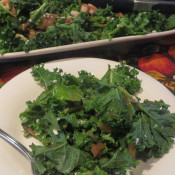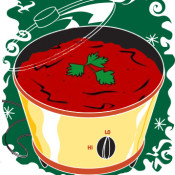Thanksgiving 2013 Part 1: Pumpkin Cheesecake

We are just under two weeks away from my favorite and most heartfelt holiday of the year. Thanksgiving is a day that, regardless of what the retail world may want you to believe, should be devoted to spending time with family and friends, and giving thanks for all of life’s blessings. I am fortunate and thankful to have health and happiness in my family this year, as we also await the arrival of our newest family member, my nephew-to-be, who is scheduled to arrive any day now. It is also a year for my family to keep close loved ones who are going through some difficult times in thoughts and prayers.
On a more light-hearted note, I am also very thankful to have a few near and dear friends who have offered to contribute to this year’s Thanksgiving blog post. If you recall my Thanksgiving recap post from last year, you’ll know that I’ve exhausted all of the Thanksgiving family recipes that I personally have to offer. My Mom’s table and Thanksgiving menu is only so big, after all! For last year’s recap, click here.
For this week’s post, I am happy to share with you a pumpkin cheesecake recipe that was passed along by our very close and dear friend, Chrissy Morabito Bussler. Most people now measure the start of the autumn season based on the first falling leaves or the sip of their first pumpkin latte. I, however, base the start of the fall season on Chrissy and her husband Carl’s Havertown Day open house party. The township day celebration has become an annual event at their house, complete with friends gathered around a table packed with delicious food (how else would an Italian girl celebrate Havertown day?). This year, Chrissy served up this tremendous pumpkin cheesecake, and when she offered to share it with me for my blog, I could not resist. It’s a very delicious, decadent version of classic cheesecake, and is the perfect alternative to traditional pumpkin pie. If you are looking for a real end-of-meal crowd pleaser to share with you family this Thanksgiving, this is the recipe to go for!
Thank you Chrissy and Carl for allowing me to share your recipe and photo!
Next week, I’ll be sharing with you a very funny and witty description of an Italian Thanksgiving dinner, as only my good friend Natalie Stone could describe it. In the meantime, please be sure to visit Natalie at Bella’s Biscotti by clicking here. She offers the most delicious biscotti around…perfect for the holiday season, so place your orders soon!
Now, for the Pumpkin Cheesecake.
PUMPKIN CHEESECAKE
Ingredients
1 1/2 cups graham cracker crumbs, crushed
1/3 cup butter, melted
1/4 cup sugar
1/3 sugar
1 cup sugar
3 packages (eight ounces each) cream cheese, softened
1/4 cup packed light brown sugar
2 eggs
1 3/4 cups (15 ounce can) pure pumpkin
2/3 cup evaporated milk
2 tablespoons cornstarch
1 1/4 teaspoons cinnamon
1/2 teaspoon nutmeg
2 cups (16 ounces) sour cream
1 teaspoon vanilla
Crust Directions
Preheat oven to 350 degrees.
Spray the bottom and sides of the spring form pan with non-stick spray.
Combine graham crackers, butter and 1/4 cup sugar in medium bowl.
Press onto bottom and 1 inch side up of 9 inch spring form pan.
Bake for 6 to 8 minutes. (Do not allow to brown) and cool on wire rack for 10 minutes.
Cheesecake Directions:
Preheat oven to 350 degrees.
Beat cream cheese, 1 cup sugar and brown sugar in a large mixer bowl until fluffy.
Beat in eggs, pumpkin and evaporated milk.
Add cornstarch, cinnamon and nutmeg.
Beat well and pour into crust.
Bake for 55 to 60 minutes or until edge is set but center still moves slightly.
Topping Directions:
Preheat oven to 350 degrees.
Combine sour cream, 1/3 cup sugar and vanilla in a small bowl.
Mix well.
Spread over surface of warm cheesecake.
Bake for five minutes.
Cool on wire rack.
Chill for several hours or overnight.
Remove side of spring form pan.

Photo courtesy of Carl Bussler





Recent Comments